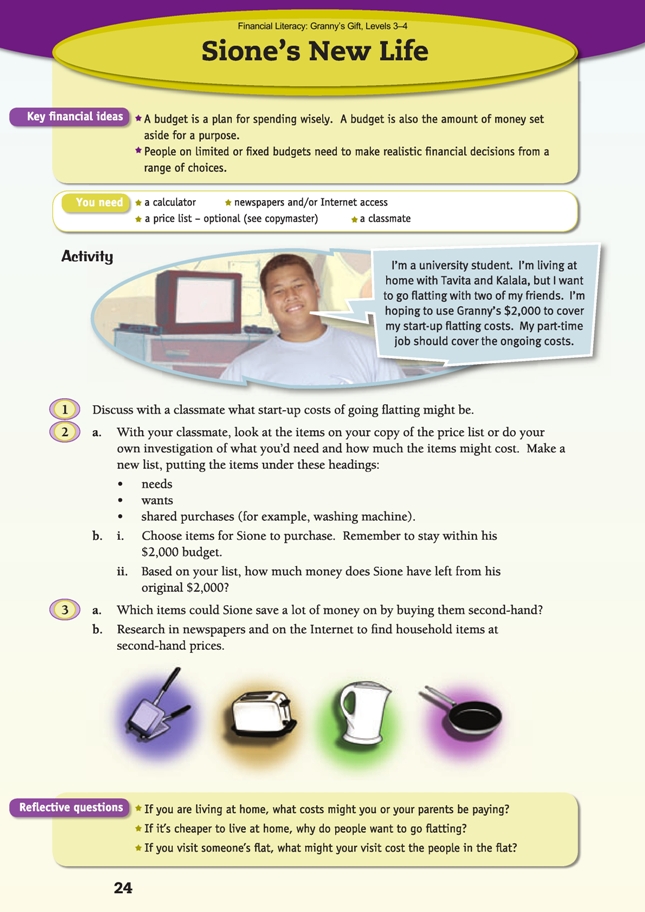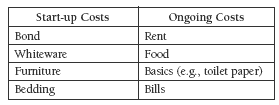Sione's New Life
This is a level 3 number activity from the Figure It Out series. It relates to Stage 6 of the Number Framework.
A PDF of the student activity is included.
Click on the image to enlarge it. Click again to close. Download PDF (783 KB)
find 1/3 of money amounts
use addition to solve money problems
Number Framework Links
This activity is appropriate for students working at stage 6 and above. It involves theaddition and subtraction of whole numbers and simple decimal numbers. (See the table of NDP material on page 4.)
Newspaper and/or internet access
A calculator
FIO, Level 3-4, Financial Literacy: Granny’s Gift, Sione's New Life, page 24
A classmate
Financial understanding
In this activity, Sione needs to be financially successful and independent when he goes flatting with his friends, so he needs to develop a budget (make a financial plan) of the costs he will incur to set himself up for flatting. Financial planning is important for personal and financial success.
The students are required to create a budget for the items that Sione needs and wants to set up his flat. A wholegroup discussion for question 1 may be more beneficial than discussion within pairs. Students will need to clarify their understanding of start-up costs versus ongoing costs. Some flatting examples include:
Extension
Financial understanding
Many students are very motivated by the idea of investing in the share market.
At the start of term, you could assign the students various sums of virtual money. Pairs of students (randomly assigned) are able to invest their “money” on the share market. Have students look in the financial pages of the newspaper to select how they will invest their money. It is useful to have outside visitors (for example, someone
from the local bank) come to discuss with students how to invest wisely. The investment is then “locked in” for the rest of the school term and the one following. At the end of that second term, students can find the value of their shares and calculate their gain (or loss).
Social Sciences Links
Social Sciences achievement objectives:
• Understand how people make decisions about access to and use of resources (Social Studies, level 3)
• Understand how producers and consumers exercise their rights and meet their responsibilities (Social Studies, level 4)
For Activity Two, the students could consider investigating the following questions: What rights and responsibilities does Tavita have as an investor (consumer of the stock exchange)? Who and what “protects” (governs) these rights and responsibilities?
The activity in question 2 may be more meaningful for students if they have to research real catalogues and the Internet using current prices. The students first need to clarify the items they would need to begin flatting rather than the items they may want (that is, luxury items). The students may need help from you to clarify the
difference! The whiteware required for flatting usually includes a fridge and a washing machine (although students may argue that they could use a laundromat instead). Basic furniture items include a bed and perhaps a desk, couch, table, and chairs. Also needed are utensils to cook with, something to eat off, and basic bathroom essentials (for example, towels).
Students may like to work in groups of three (as Sione is flatting with two others) and decide what to buy together. Perhaps each student could be responsible for purchasing one major item (such as a fridge, a washing machine, or furniture) and a few of the kitchen pieces. Each will need their own bed, bedding, towels, and so
on.
Encourage students to prioritise their spending. An iron, vacuum cleaner, and coffee mugs should come before stereo systems, flat screen TVs, and DVD players. Total spending must not exceed $2,000 per flatmate.
If flatting is not something that your students are interested in at this point, you could explore the concept of budgeting by framing the activity around budgeting for a class trip. They could prioritise aspects such as fun activities, food, and costs for the trip, transport, accommodation, and so on.
Extension
Financial understanding
Budgeting for purchases is an excellent way to practise estimation in a real context. A follow-up activity could include giving the students a budget to redesign their bedroom from scratch. Students must purchase needed items first (for example, bed, drawers, desk) and may spend the rest of their budget on wants.
Social Sciences Links
Achievement objectives:
• Understand how people make choices about their needs and wants (Social Studies, level 2)
• Understand how people make decisions about access to and use of resources (Social Studies, level 3)
The students could discuss what they think is influencing Sione’s decisions more: his needs or his wants. They could then compare what they chose for Sione to purchase first to satisfy his needs or wants.
Other Cross-curricular Links
English achievement objective:
• Processes and strategies: Integrate sources of information, processes, and strategies with increasing confidence/confidently to identify, form, and express ideas (Speaking, Writing, and Presenting, levels 3–4)
Students could use telephone directories, catalogues, the Internet, and other sources to find items such as furniture for sale.
Answers to Activity
1. Discussion will vary. Flatting costs may include bond, rent in advance, whiteware, furniture, bedding, cleaning equipment, basics such as toilet paper, as well as the cost of phone installation and immediate food needs.
2. a.–b. Answers will vary.
3. a. Answers will vary. He might save a lot of money on big second-hand items, such as whiteware, furniture, and a bed.
b. Prices will vary.
Reflective questions
Answers will vary.
• Costs that either you or your parents would need to cover would include power, phone (with or without toll calls), heating if other than power (for example, gas or wood), food, cleaning products, toilet paper, and so on.
• Some people like to live with other people their own age, be closer to university or work, be able to come and go more freely, play louder music, and so on.
• The people living in the flat often end up paying for the food their visiting friends eat, the power they use, toilet paper, phone calls, and so on. Some visitors use their friends’ flats (and cars) without thinking of the costs involved.

